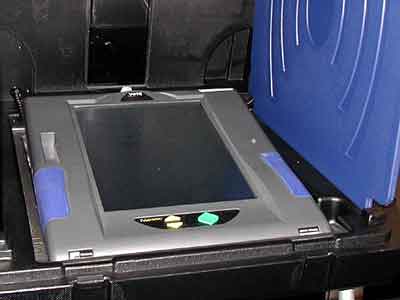 According to a May 22,
2003 press
release from Rep. Rush Holt (D-NJ): According to a May 22,
2003 press
release from Rep. Rush Holt (D-NJ):
Rep. Rush Holt today responded to the
growing chorus of concern from election reform
specialists and computer security experts about the
integrity of future elections by introducing reform
legislation, The Voter Confidence and Increased
Accessibility Act of 2003. The measure would require
all voting machines to produce an actual paper record
by 2004 that voters can view to check the accuracy of
their votes and that election officials can use to
verify votes in the event of a computer malfunction,
hacking, or other irregularity. Experts often refer to
this paper record as a “voter-verified paper
trail.” 
The above photo is from a May 9, 2003 Wired
article, and is of a prototype machine cobbled
together by voting machine manufacturer ES&S. After
the voter makes selections on the touch screen, a paper
ballot is printed and appears behind the vertical clear
plastic window that is behind the touch screen device.
The voter has an opportunity to verify that the paper
ballot reflects the intended vote.
In order for the U.S. to continue as a democracy, it
is critical that votes be human-verifiable, so that any
election may be independently verifiable by any group of
people. Otherwise, he who owns the machines owns the
vote. Unfortunately, the 2000 Florida fiasco is being
used as a ruse to go toward touchscreen only by blaming
paper. Avoiding paper would just be sweeping the problem
under the rug and facilitate easier theft of elections.
The answer is a stronger paper trail -- one that
can be verified by both the voter and the independent
vote counter.
See also the Feb. 28, 2003 UnderReported.com story Finally,
the truth about electronic voting comes
out.
|



